Teaching music skills to children through singing
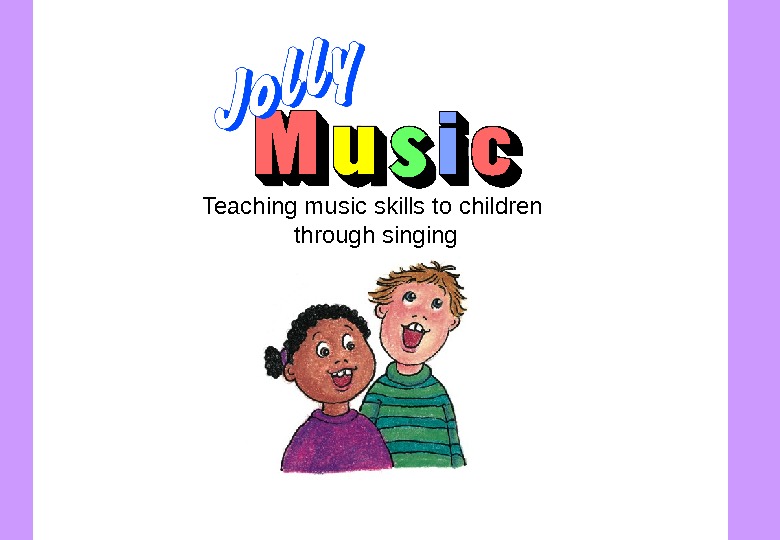
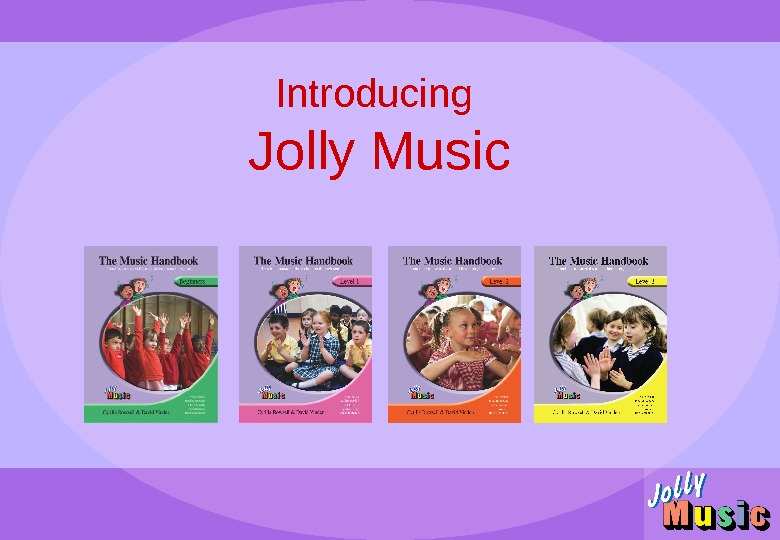








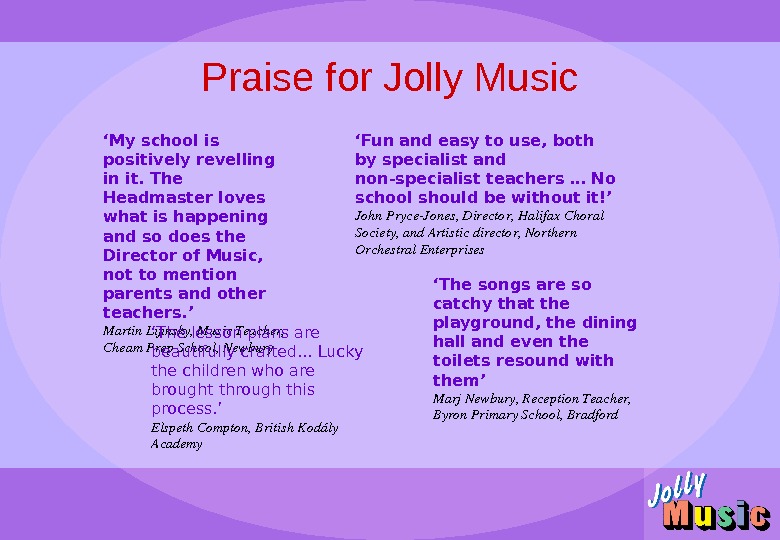
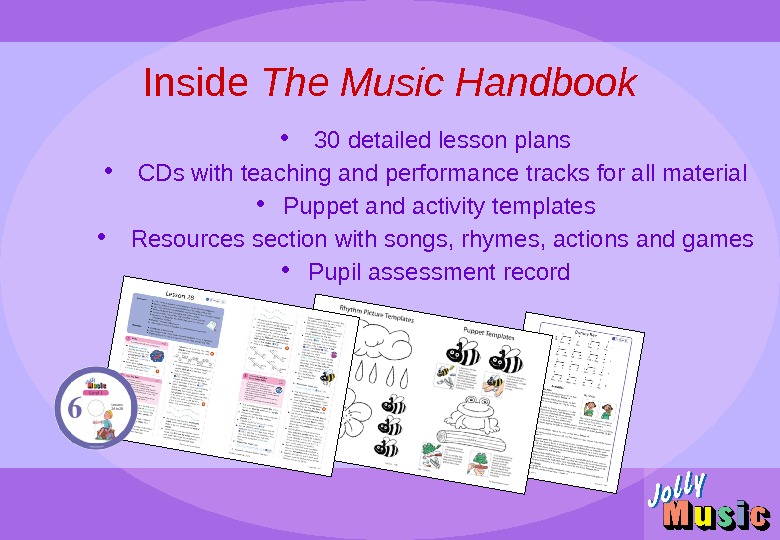
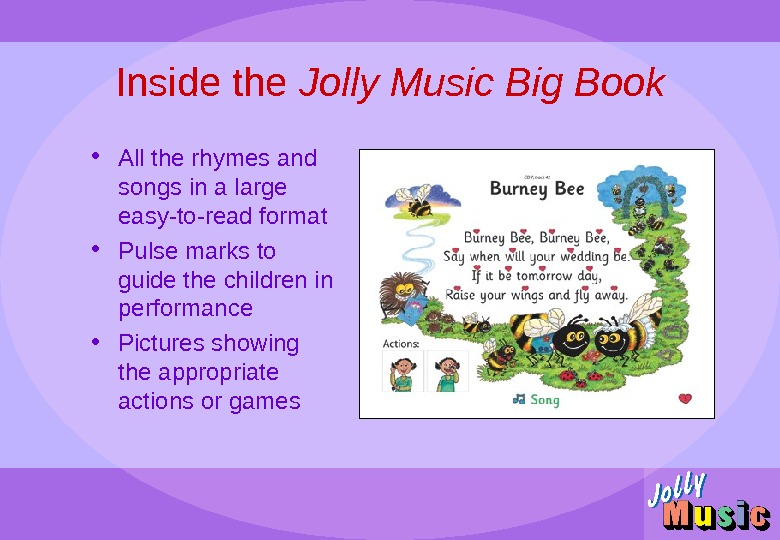
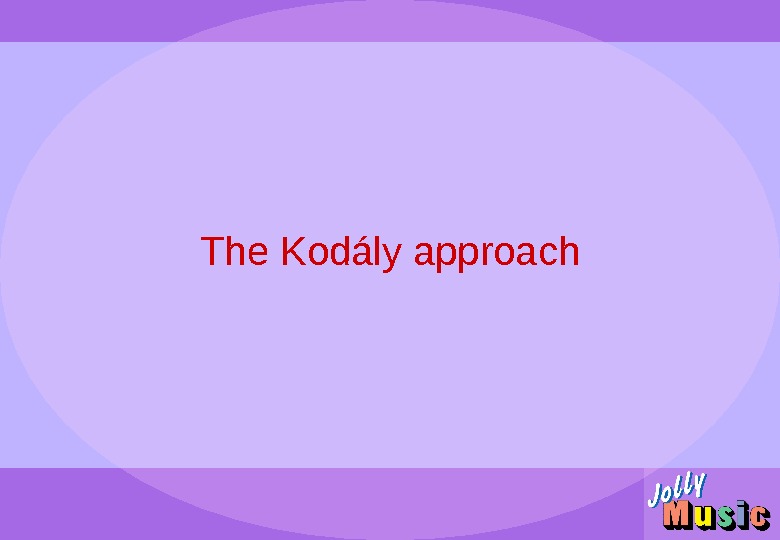







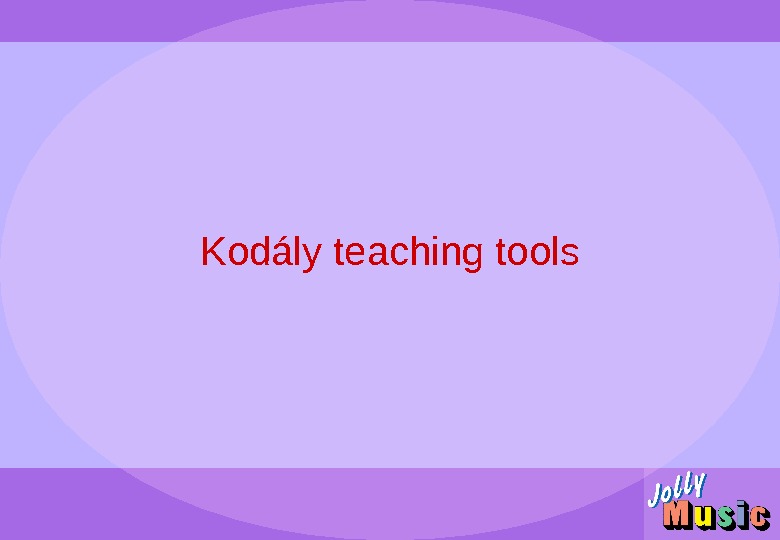
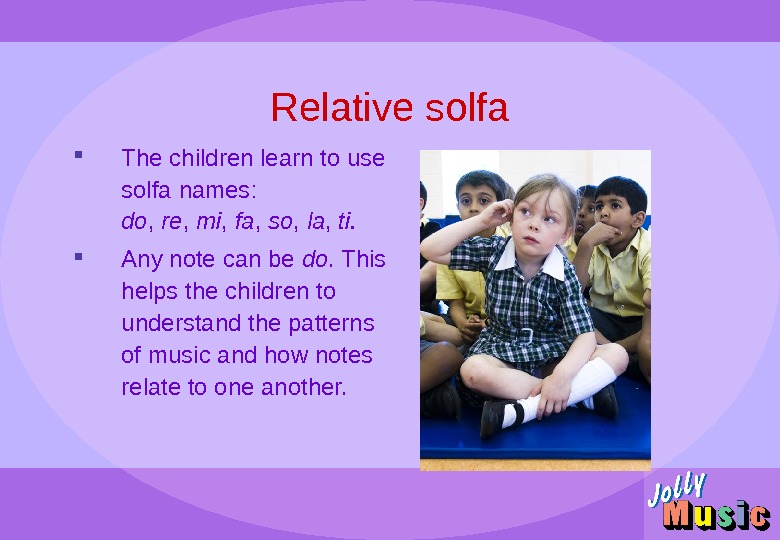
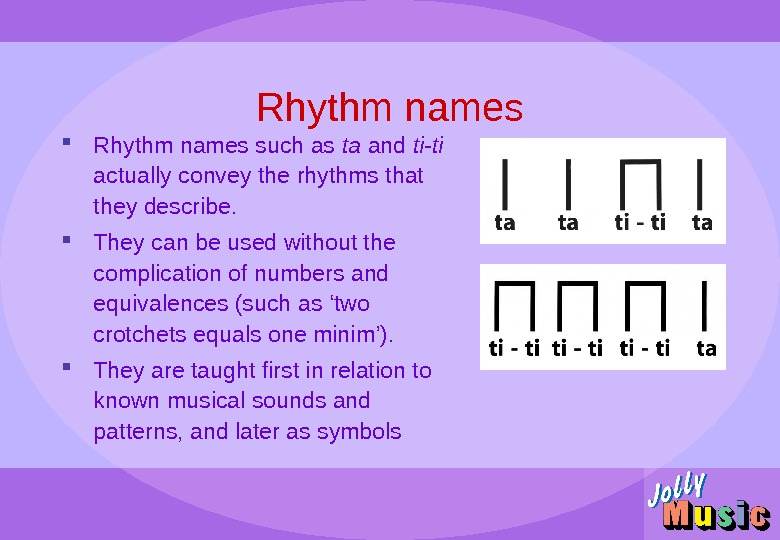




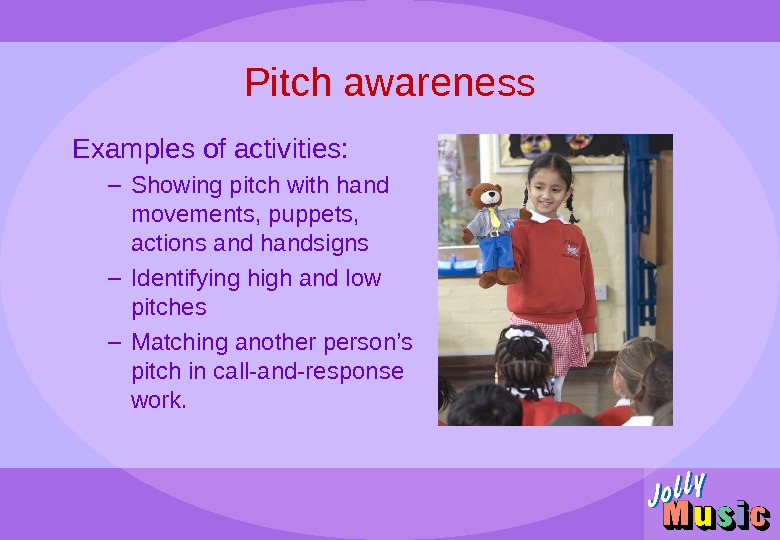









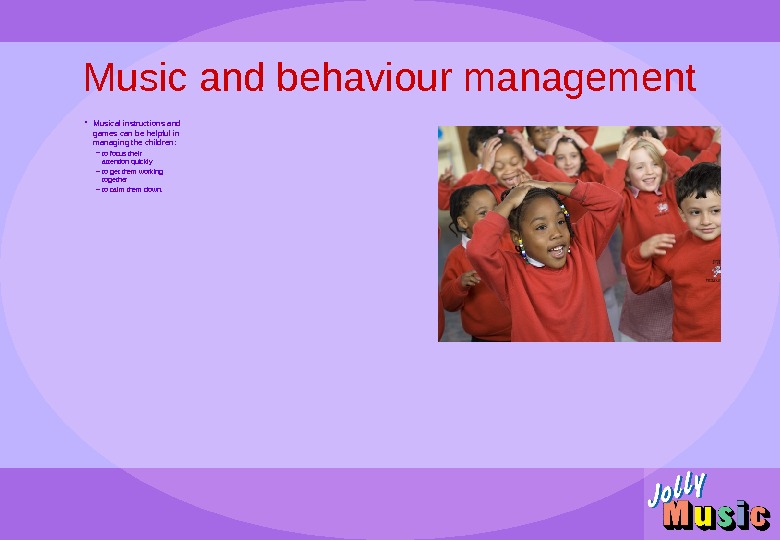





- Размер: 33.8 Mегабайта
- Количество слайдов: 44
Описание презентации Teaching music skills to children through singing по слайдам
 Teaching music skills to children through singing
Teaching music skills to children through singing
 Introducing Jolly Music
Introducing Jolly Music
 For non-specialist teachers… Well sequenced lesson plans No need to sing — all tracks on supporting CDs No music reading needed Make music part of everyday classroom life. Jolly. Musichasbeendevelopedtobringthebestand mosteffectivemusicteachingwithinthereachofany teacher–eventhosewithoutanymusicalexperience
For non-specialist teachers… Well sequenced lesson plans No need to sing — all tracks on supporting CDs No music reading needed Make music part of everyday classroom life. Jolly. Musichasbeendevelopedtobringthebestand mosteffectivemusicteachingwithinthereachofany teacher–eventhosewithoutanymusicalexperience
 … and for specialist music teachers Lesson plans based on Kod ály principles Resources section allows flexible use of materials Music notation provided. Musicspecialistswillfind. Jolly. Musicaflexibleand powerfulresource, fullofideasandactivities, allwith cleargoalsintermsofthechildren’sskills.
… and for specialist music teachers Lesson plans based on Kod ály principles Resources section allows flexible use of materials Music notation provided. Musicspecialistswillfind. Jolly. Musicaflexibleand powerfulresource, fullofideasandactivities, allwith cleargoalsintermsofthechildren’sskills.
 The best music teaching • The lessons are carefully sequenced and progressive. • The programme builds key musical skills right from the start. • The children acquire an excellent foundation for instrumental learning.
The best music teaching • The lessons are carefully sequenced and progressive. • The programme builds key musical skills right from the start. • The children acquire an excellent foundation for instrumental learning.
 Beginners’ Level (ages 4 -7) availablenow 144 pages 6 CDs
Beginners’ Level (ages 4 -7) availablenow 144 pages 6 CDs
 Level 1 (ages 5 -8) availablenow 192 pages 7 CDs
Level 1 (ages 5 -8) availablenow 192 pages 7 CDs
 Level 2 (ages 6– 9) availablenow 208 pages 7 CDs
Level 2 (ages 6– 9) availablenow 208 pages 7 CDs
 Level 3 (ages 7– 10) Available. Autumn 2011 208 pages 7 CDs
Level 3 (ages 7– 10) Available. Autumn 2011 208 pages 7 CDs
 A complete primary music curriculum • Each level provides a complete, well-planned music curriculum for one year. • The finished programme will have seven levels, one for each year of primary school • The suggested starting age is 4– 5 years (Reception), but the programme may be started as late as age 7 (Year 3).
A complete primary music curriculum • Each level provides a complete, well-planned music curriculum for one year. • The finished programme will have seven levels, one for each year of primary school • The suggested starting age is 4– 5 years (Reception), but the programme may be started as late as age 7 (Year 3).
 Praise for Jolly Music ‘ My school is positively revelling in it. The Headmaster loves what is happening and so does the Director of Music, not to mention parents and other teachers. ’ Martin. Lijinsky, Music. Teacher, Cheam. Prep. School, Newbury ‘ Fun and easy to use, both by specialist and non-specialist teachers … No school should be without it!’ John. Pryce. Jones, Director, Halifax. Choral Society, and. Artisticdirector, Northern Orchestral. Enterprises ‘ The songs are so catchy that the playground, the dining hall and even the toilets resound with them’ Marj. Newbury, Reception. Teacher, Byron. Primary. School, Bradford‘ The lesson plans are beautifully crafted… Lucky the children who are brought through this process. ’ Elspeth. Compton, British. Kodály Academy
Praise for Jolly Music ‘ My school is positively revelling in it. The Headmaster loves what is happening and so does the Director of Music, not to mention parents and other teachers. ’ Martin. Lijinsky, Music. Teacher, Cheam. Prep. School, Newbury ‘ Fun and easy to use, both by specialist and non-specialist teachers … No school should be without it!’ John. Pryce. Jones, Director, Halifax. Choral Society, and. Artisticdirector, Northern Orchestral. Enterprises ‘ The songs are so catchy that the playground, the dining hall and even the toilets resound with them’ Marj. Newbury, Reception. Teacher, Byron. Primary. School, Bradford‘ The lesson plans are beautifully crafted… Lucky the children who are brought through this process. ’ Elspeth. Compton, British. Kodály Academy
 Inside The Music Handbook • 30 detailed lesson plans • CDs with teaching and performance tracks for all material • Puppet and activity templates • Resources section with songs, rhymes, actions and games • Pupil assessment record
Inside The Music Handbook • 30 detailed lesson plans • CDs with teaching and performance tracks for all material • Puppet and activity templates • Resources section with songs, rhymes, actions and games • Pupil assessment record
 Inside the Jolly Music Big Book • All the rhymes and songs in a large easy-to-read format • Pulse marks to guide the children in performance • Pictures showing the appropriate actions or games
Inside the Jolly Music Big Book • All the rhymes and songs in a large easy-to-read format • Pulse marks to guide the children in performance • Pictures showing the appropriate actions or games
 The Kod ály approach
The Kod ály approach
 Music is for everyone Every child can be taught musical skills All children taught in this way can develop their ability to pitch accurately No child should ever be told that he or she cannot sing “ Every sound child with good eyes and ears is able to learn music and should learn music. ” Zolt á n Kod á ly
Music is for everyone Every child can be taught musical skills All children taught in this way can develop their ability to pitch accurately No child should ever be told that he or she cannot sing “ Every sound child with good eyes and ears is able to learn music and should learn music. ” Zolt á n Kod á ly
 Begin early Between 3 and 7 years is the ideal age to start. Jolly Music can be used in primary schools from Reception year (age 4– 5) onward. The approach is child-centred and developmental.
Begin early Between 3 and 7 years is the ideal age to start. Jolly Music can be used in primary schools from Reception year (age 4– 5) onward. The approach is child-centred and developmental.
 Teach music skills through singing Singing is a joyful and sociable activity. Everyone has a voice, and it’s free. It is the most direct way of making a musical response. Singing is an internal skill; playing an instrument is external. Singing engages the inner hearing.
Teach music skills through singing Singing is a joyful and sociable activity. Everyone has a voice, and it’s free. It is the most direct way of making a musical response. Singing is an internal skill; playing an instrument is external. Singing engages the inner hearing.
 Sound before symbol Training the ear comes before the children learn to read and write music. The aim is for them to be able to hear what is written, and write what they hear. They start with simple visual representations of pitch and rhythm.
Sound before symbol Training the ear comes before the children learn to read and write music. The aim is for them to be able to hear what is written, and write what they hear. They start with simple visual representations of pitch and rhythm.
 Use only the best material Kod ály recommended folk music as the most suitable musical material. Jolly Music uses playground rhymes and songs — the folk music of childhood.
Use only the best material Kod ály recommended folk music as the most suitable musical material. Jolly Music uses playground rhymes and songs — the folk music of childhood.
 Choose singable songs The rhymes and songs in Jolly Music used are chosen for their small range and simple rhythms. Most are based on the interval so-mi – the natural and familiar sound of calls like ‘Mum-my’ or ‘co-ee’.
Choose singable songs The rhymes and songs in Jolly Music used are chosen for their small range and simple rhythms. Most are based on the interval so-mi – the natural and familiar sound of calls like ‘Mum-my’ or ‘co-ee’.
 From the known to the unknown • Learning takes place in three stages: 1. Unconscious experience (preparation) Example: The children sing a song many times and clap the pulse when they sing it. 2. Making conscious (presentation) Example: The children learn the word ‘heartbeat’ or ‘pulse’ to describe what they have been clapping. 3. Reinforcement (practice) Example: The children listen to a new song and try to clap the pulse.
From the known to the unknown • Learning takes place in three stages: 1. Unconscious experience (preparation) Example: The children sing a song many times and clap the pulse when they sing it. 2. Making conscious (presentation) Example: The children learn the word ‘heartbeat’ or ‘pulse’ to describe what they have been clapping. 3. Reinforcement (practice) Example: The children listen to a new song and try to clap the pulse.
 Kod á ly teaching tools
Kod á ly teaching tools
 Relative solfa The children learn to use solfa names: do , re , mi , fa , so , la , ti. Any note can be do. This helps the children to understand the patterns of music and how notes relate to one another.
Relative solfa The children learn to use solfa names: do , re , mi , fa , so , la , ti. Any note can be do. This helps the children to understand the patterns of music and how notes relate to one another.
 Rhythm names such as ta and ti-ti actually convey the rhythms that they describe. They can be used without the complication of numbers and equivalences (such as ‘two crotchets equals one minim’). They are taught first in relation to known musical sounds and patterns, and later as symbols
Rhythm names such as ta and ti-ti actually convey the rhythms that they describe. They can be used without the complication of numbers and equivalences (such as ‘two crotchets equals one minim’). They are taught first in relation to known musical sounds and patterns, and later as symbols
 Handsigns help the children to visualise pitch; they provide a kinaesthetic link to the sound
Handsigns help the children to visualise pitch; they provide a kinaesthetic link to the sound
 Movement • Children learn best about pulse and rhythm through movement. • As well as clapping, they perform the pulse through a variety of movements including walking. • Through the many games they learn to co-ordinate their movements with the music.
Movement • Children learn best about pulse and rhythm through movement. • As well as clapping, they perform the pulse through a variety of movements including walking. • Through the many games they learn to co-ordinate their movements with the music.
 Musical skills
Musical skills
 Musical memory Examples of activities: – Learning and recalling rhymes and songs – Recognising a rhyme or song from its hummed melody or tapped rhythm – Identifying the same rhythm in different rhymes and songs.
Musical memory Examples of activities: – Learning and recalling rhymes and songs – Recognising a rhyme or song from its hummed melody or tapped rhythm – Identifying the same rhythm in different rhymes and songs.
 Pitch awareness Examples of activities: – Showing pitch with hand movements, puppets, actions and handsigns – Identifying high and low pitches – Matching another person’s pitch in call-and-response work.
Pitch awareness Examples of activities: – Showing pitch with hand movements, puppets, actions and handsigns – Identifying high and low pitches – Matching another person’s pitch in call-and-response work.
 Inner hearing Examples of activities: – Using the ‘thinking voice’ — children tap rhythm while ‘singing’ in their head – Identifying a song from its rhythm alone – Performing rhythm of question-and-answer songs in groups or pairs.
Inner hearing Examples of activities: – Using the ‘thinking voice’ — children tap rhythm while ‘singing’ in their head – Identifying a song from its rhythm alone – Performing rhythm of question-and-answer songs in groups or pairs.
 A sense of pulse Examples of activities: – Performing the pulse (the ‘heartbeat’) of songs with learned or improvised actions – Using puppets to show the pulse – Walking or clapping the pulse as part of a game.
A sense of pulse Examples of activities: – Performing the pulse (the ‘heartbeat’) of songs with learned or improvised actions – Using puppets to show the pulse – Walking or clapping the pulse as part of a game.
 Understanding rhythm Examples of activities: – Performing rhythm by tapping, clapping or other actions – Relating rhythm to pulse – Creating ‘rhythm pictures’ – Learning the rhythm syllables ‘ta’ and ‘ti-ti’.
Understanding rhythm Examples of activities: – Performing rhythm by tapping, clapping or other actions – Relating rhythm to pulse – Creating ‘rhythm pictures’ – Learning the rhythm syllables ‘ta’ and ‘ti-ti’.
 Listening Examples of activities : – Responding to musical instructions without words – Guessing games – Observing and discussing classmates’ performance – Listening to and discussing new songs.
Listening Examples of activities : – Responding to musical instructions without words – Guessing games – Observing and discussing classmates’ performance – Listening to and discussing new songs.
 Ensemble work It takes mutual awareness and teamwork to perform together. Examples of activities: – Question and answer songs – Performing in separate groups or as duets – Taking turns to perform a line or verse of a song – Co-ordinating actions
Ensemble work It takes mutual awareness and teamwork to perform together. Examples of activities: – Question and answer songs – Performing in separate groups or as duets – Taking turns to perform a line or verse of a song – Co-ordinating actions
 Jolly Music in the classroom
Jolly Music in the classroom
 Singing games • The combination of singing and rhythmic movement provides a ideal unconscious learning experience • Children love these games and are happy to repeat them endlessly • They make their own of the games, taking them from the classroom into the playground
Singing games • The combination of singing and rhythmic movement provides a ideal unconscious learning experience • Children love these games and are happy to repeat them endlessly • They make their own of the games, taking them from the classroom into the playground
 The ‘singing chair’ An ordinary chair, decorated and perhaps labelled, can give the children confidence in solo singing. Tell the children that it will help them to sing really well when they sit on it and sing on their own. ‘ Our children all speak English as a second language. They can also be shy and sometimes withdrawn. What a difference Jolly Music makes. Everyone wanted a turn on the chair. ’’ Marj. Newbury, Reception. Teacher, Byron. Primary. School, Bradford
The ‘singing chair’ An ordinary chair, decorated and perhaps labelled, can give the children confidence in solo singing. Tell the children that it will help them to sing really well when they sit on it and sing on their own. ‘ Our children all speak English as a second language. They can also be shy and sometimes withdrawn. What a difference Jolly Music makes. Everyone wanted a turn on the chair. ’’ Marj. Newbury, Reception. Teacher, Byron. Primary. School, Bradford
 Solo performance • It builds the children’s confidence. • It allows you to assess each child individually. • It makes the children listen; they perform better as a group after listening to a soloist perform.
Solo performance • It builds the children’s confidence. • It allows you to assess each child individually. • It makes the children listen; they perform better as a group after listening to a soloist perform.
 Music and behaviour management • Musical instructions and games can be helpful in managing the children: – to focus their attention quickly – to get them working together – to calm them down.
Music and behaviour management • Musical instructions and games can be helpful in managing the children: – to focus their attention quickly – to get them working together – to calm them down.
 Make singing as natural as speaking • Sung greetings (‘Hello everyone’, ‘Goodbye, everyone’) and instructions (‘Stand up!’, ‘Sit down’ etc. ) are used throughout Jolly Music. • They can be used in any classroom situation and are easily adapted to other words.
Make singing as natural as speaking • Sung greetings (‘Hello everyone’, ‘Goodbye, everyone’) and instructions (‘Stand up!’, ‘Sit down’ etc. ) are used throughout Jolly Music. • They can be used in any classroom situation and are easily adapted to other words.
 Music every day • Many of the Jolly Music activities can easily be used daily by the class teacher, even where the regular music lesson is given by a music specialist. • The CDs make it easy for the teachers to share material.
Music every day • Many of the Jolly Music activities can easily be used daily by the class teacher, even where the regular music lesson is given by a music specialist. • The CDs make it easy for the teachers to share material.
 Music and learning
Music and learning
 Music and achievement. Children at a Glasgow nursery who received Kodály-based music lessons were 12 months ahead of their chronological age in literacy by the end of primary 1 (age 5). 1 First-grade children at a US school who received intensive Kod ály training performed more effectively than a control group on temporal and spatial tasks and on reading tests. 2 Six-year-olds receiving either Kod á ly or keyboard lessons showed ‘modest but widespread intellectual benefits’, in areas including concentration, processing speed, reading and maths skills, perceptual organisation and overall IQ. 3 1. Myant, M. , Armstrong, W. & Healy, N. (2008). Can music make a difference? A small scale longitudinal study into the effects of music instruction in nursery on later reading ability. Educational & Child Psychology , 25 ( 3), 79– 96 2. Gardiner, M. F. , Fox, A. , Knowles, F. & Jeffrey, D. (1996). Learning improved by arts training. Nature , 381 , 284. 3. Glenn Schellenberg, E. (2004). Music Lessons Enhance IQ. Psychological Science, 15, 511.
Music and achievement. Children at a Glasgow nursery who received Kodály-based music lessons were 12 months ahead of their chronological age in literacy by the end of primary 1 (age 5). 1 First-grade children at a US school who received intensive Kod ály training performed more effectively than a control group on temporal and spatial tasks and on reading tests. 2 Six-year-olds receiving either Kod á ly or keyboard lessons showed ‘modest but widespread intellectual benefits’, in areas including concentration, processing speed, reading and maths skills, perceptual organisation and overall IQ. 3 1. Myant, M. , Armstrong, W. & Healy, N. (2008). Can music make a difference? A small scale longitudinal study into the effects of music instruction in nursery on later reading ability. Educational & Child Psychology , 25 ( 3), 79– 96 2. Gardiner, M. F. , Fox, A. , Knowles, F. & Jeffrey, D. (1996). Learning improved by arts training. Nature , 381 , 284. 3. Glenn Schellenberg, E. (2004). Music Lessons Enhance IQ. Psychological Science, 15, 511.
 Music and behaviour “ Just four months after the introduction of the music sessions, staff… began to notice changes in the children: not only did they show joy in music but there was also a significant reduction in aggressive play and stronger class bonding. ” ‘ Sound. Beginnings’, anaccountofthestudyat. Queen. Mary. Street. Nursery. Schoolin. Glasgow, in Early. Years. Matters , Spring 2006, 8– 9(publishedby. Learningand. Teaching. Scotland)Quality music teaching contributes to the development of the whole child, producing improvements in: • self-confidence • communication and listening skills • concentration • co-ordination • co-operation.
Music and behaviour “ Just four months after the introduction of the music sessions, staff… began to notice changes in the children: not only did they show joy in music but there was also a significant reduction in aggressive play and stronger class bonding. ” ‘ Sound. Beginnings’, anaccountofthestudyat. Queen. Mary. Street. Nursery. Schoolin. Glasgow, in Early. Years. Matters , Spring 2006, 8– 9(publishedby. Learningand. Teaching. Scotland)Quality music teaching contributes to the development of the whole child, producing improvements in: • self-confidence • communication and listening skills • concentration • co-ordination • co-operation.
